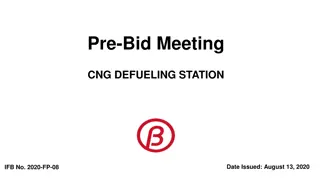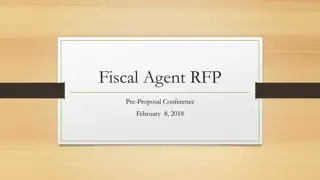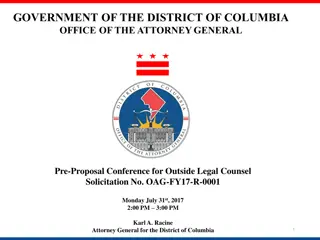Distributed Energy Resource Programmatic and Technical Analysis RFP-22-806 Overview
This RFP by the California Energy Commission aims to support analysis of customer energy use data, including AMI data, for major utilities in California. The goal is to enhance understanding of energy load, impacts of decarbonization actions, and improve energy forecasts to guide policy recommendations and program development for grid reliability and building decarbonization.
Download Presentation

Please find below an Image/Link to download the presentation.
The content on the website is provided AS IS for your information and personal use only. It may not be sold, licensed, or shared on other websites without obtaining consent from the author.If you encounter any issues during the download, it is possible that the publisher has removed the file from their server.
You are allowed to download the files provided on this website for personal or commercial use, subject to the condition that they are used lawfully. All files are the property of their respective owners.
The content on the website is provided AS IS for your information and personal use only. It may not be sold, licensed, or shared on other websites without obtaining consent from the author.
E N D
Presentation Transcript
Distributed Energy Resource Programmatic and Technical Analysis California Energy Commission Request for Proposals- RFP-22-806 Pre-Bid Conference Date: May 24, 2023
Housekeeping Workshop is being recorded. Request for proposal webpage: RFP-22-806 - Distributed Energy Resource Programmatic and Technical Analysis Virtual participation through Zoom Raise your hand or use the Q&A feature Telephone participants dial *9 to raise their hands Written questions to Commission Agreement Officer: Phil Dyer, Phil.dyer@energy.ca.gov Subject: RFP-22-806 - Distributed Energy Resource Programmatic and Technical Analysis Deadline: May 24, 2023 by 5:00 PM 2
Agenda Welcome and Introductions RFP Overview Questions and Answers Conclusion 3
Purpose of RFP Support the CEC with analysis of customer energy use data (including AMI data, as available) 5
Customer Energy Use Data Customer energy use data is collected under new CEC data collection authority (California Code of Regulations, Title 20, Section 1353) Covers six largest gas and electric utilities (SoCalGas, PG&E, SCE, SDG&E, LADWP, SMUD) Billing-level costs and consumption from all electric and natural gas meters Associated meter, account, and premise data Address Rate schedule and NAICS codes EE, NEM and other program participation Electric interval meter data (AMI data) for PG&E, SCE, SDG&E, and SMUD 6
Purpose of RFP (continued) Increase our understanding of: California's energy load. Impact of decarbonization actions and equipment on the grid, buildings, ratepayer energy costs or burden, and energy usage. Performance of decarbonization equipment and measures, including distributed energy resources (DER), under different applications. 7
Purpose of RFP (continued)1 Support the development of policy recommendations and strategies that can provide greater grid reliability, building decarbonization, and customer value. Improve energy demand and supply forecasts for the state. Guide the development and implementation of programs that deploy building and energy system decarbonization measures. Provide tools for improved and more accurate program targeting. Identify data gaps and future research needs. 8
Scope of Work Task 1 Agreement Management Task 2 DER Analytics: Leveraging Customer Energy Use Data 9
Expected Total Hours The RFP contains an error with respect to Expected Total Hours. The value listed for both Task 1 and Task 2 is one-half of what it should be. Task 1 - Expected Total Hours should be 1,150 (not 575). Task 2 Expected Total Hours should be 12,000 (not 6,000). An addendum will be issued to make the correction. Affects two RFP documents: 00 RFP-22-806 Application Manual 07 RFP-22-806 Att 07 Agreement Budget Form (Tab 7b) 10
Task 1: Agreement Management Task 1: Agreement Management Sub-Tasks: 1. Kick-off Meeting 2. Prepare and Submit Invoices Monthly 3. Manage Subcontractors 4. Prepare and Submit Progress Reports Monthly 5. Work Authorizations 6. Prepare and Submit Final Report 11
Task 2: DER Analytics Leveraging Task 2: DER Analytics Leveraging Customer Energy Use Data Customer Energy Use Data Sub-Tasks: 1. Analysis to Inform Policy Options 2. Analysis to Improve Forecasting/Planning 3. Analysis, Recommendations, Plans, and Tool Development to Support Program Development, Implementation & Verification 4. Supporting the Development of Strategies to Share Relevant Information with Interested Parties 12
Sub Sub- -Task 2.1 Task 2.1 - - Analysis to Inform Analysis to Inform Policy Options Policy Options Conduct analysis to evaluate the benefit of decarbonization activities or DER individually or in combination. Analysis may be conducted by utility territory, across all utility territories for which CEC has data, or somewhere in between. Identify customer types, equipment mixes, and geographies that provide the greatest customer and grid value. Assist CEC in conducting cost comparison of different scenarios and assess where financial incentives may be necessary to support deployment to meet other state priorities, such as for energy equity. Conduct analysis of both electric and fossil gas use that assists in informing decarbonization policy. 13
Sub Sub- -Task 2.2 Task 2.2 - - Analysis to Improve Analysis to Improve Forecasting/Planning Forecasting/Planning Conduct analyses to inform the electricity hourly load shapes used for DER end-uses in the California Energy Demand forecast. Assess how a customer s electricity and fossil gas consumption changes with DER adoption by comparing electricity and gas consumption before and after adoption. Work with CEC to identify potential future scenarios of DER deployment and analyze how the scenarios might impact customer energy use and cost and electric system reliability. 14
Sub Sub- -Task 2.3 Task 2.3 - - Analysis to Support Analysis to Support Programs Programs Conduct analyses to inform program design, development, requirements, and implementation. Develop and provide plans, recommendations, tools, and/or program support for program EM&V. Develop tools to analyze customer energy use data and decarbonization and resiliency measures, in coordination with other data. Work with CEC to evaluate program effectiveness and make improvements. Support and provide training and resources to CEC staff and program implementers. Support the development and training of CEC staff to strengthen their skills and ability to conduct analysis of customer energy use data. 15
Sub Sub- -Task 2.4 Task 2.4 - - Development of Development of Strategies to Share Information Strategies to Share Information Support the CEC in developing strategies that may include anonymizing or otherwise aggregating data to a level that enables sharing the information without releasing PII or other confidential data and is useful for planners and program implementers, including communities, community choice aggregators, and DER deployment program implementers. This may include advice on how to make this data available through CEC s existing data infrastructure or CEC s planning library, which is in development. 16
Eligible Bidders Eligible Bidders Bidders must meet all solicitation requirements. Private entities, non-profit organizations, and public sector entities that meet the solicitation requirements. Private sector entities must agree to the Energy Commission s standard terms and conditions. The University of California or the U.S. DOE National Laboratories must use either the standard or the pre-negotiated terms and conditions. Public entities may participate as subcontractors if they cannot meet requirements or agree to the terms. All corporations, LLCs and LPs are required to register and be in good standing with the California Secretary of State. 17
Proposal Requirements Proposal Requirements Proposals Consists of two Sections Section 1: Administrative Response Section 2: Technical Proposal and Cost Proposal Cover Letter Table of Contents Contractor Status Form Darfur Contracting Act Form Small Business Certification (If applicable) Completed Disabled Veteran Business Enterprise form Bidder Declaration form GSPD-05-105 Contractor Certification Clauses TACPA Forms Iran Contracting Act Form CA Civil Rights Laws Certification Approach to Tasks in Scope of Work Organizational Structure Relevant Experience and Qualifications Labor Hours by Personnel and Task Client References Key Personnel Resumes Previous Work Products Budget Forms 18
Evaluation Process Evaluation Process Stage One: Administrative and Completeness Screening Stage Two: Technical and Cost Evaluation of Proposals Must pass Technical Criteria for further evaluation. The Maximum Points Available under this RFP are 100 Minimum Passing Score For the technical Criteria 56 points (70%) For the whole proposal 70 points (70%) 19
SCREENING CRITERIA FOR HANDLING OF COMMISSION SCREENING CRITERIA FOR HANDLING OF COMMISSION (OR A THIRD PARTY) CONFIDENTIAL INFORMATION (OR A THIRD PARTY) CONFIDENTIAL INFORMATION This solicitation anticipates that the Contractor may receive Confidential Information or Personal Information from the Energy Commission (or a third party) or be required to handle Confidential Information or Personal Information belonging to someone other than Contractor. Because of the need for security in handling this Confidential Information and Personal Information, the Energy Commission will screen applicants based on their existing security processes. Bidder s responses will be evaluated in Stage One Administrative and Completeness Screening. (Pages 19-20) Note: Attachment 8 Exhibit D Special Terms and Conditions for Consulting Services 20
Scoring Scoring Technical Criteria Possible Points 30 Bidder s Approach to the Tasks in the Scope of Work Past Experience and Its Relevance to the Scope of Work 10 Approach to Managing Work Organization 15 Approach to Managing Work Program Management 10 Client References 5 Total (Minimum Passing Score of 56) 70 Cost Criteria Possible Points Total Expected Labor Costs (Cost Points) 15 Cost Justification (Cost Points) 15 Total (Minimum Passing Score of 70) 100 21
Disabled Veteran Business Enterprise Disabled Veteran Business Enterprise (DVBE) Requirements (DVBE) Requirements This RFP is NOT subject to a mandatory certified DVBE participation. Bidders that both receive the minimum passing score and include DVBE participation in its Bid will receive the DVBE Incentive. 22
How To Submit The Proposals The method of submission for this solicitation is the CEC Grant Solicitation System, available at: https://gss.energy.ca.gov/. This online tool allows applicants to submit their electronic documents to the CEC prior to the date and time specified in this solicitation. Application documents should meet formatting requirements, and page limits specified. See individual requirements for each attachment in Section III. of the solicitation manual (starts on page 13). Deadline to Submit Proposals by 5:00 p.m. on June 21, 2023 23
Tentative Key Activities and Dates1 ACTIVITY ACTION DATE May 18, 2023 May 24, 2023 RFP Release Pre-Bid Conference * Deadline for Written Questions by 5:00 p.m. May 24, 2023 Distribute Questions/Answers and Addenda (if any) to RFP Deadline to Submit Proposals by 5:00 p.m. Notice of Proposed Award Commission Business Meeting Contract Start Date Contract Termination Date June 2, 2023 June 21, 2023 July 7, 2023 August 9, 2023 September 2023 October 2026 24
Questions and Answers Please introduce yourself by stating your name and affiliation. Please follow up with your question in writing to ensure that it is captured properly. Our official response will be given in writing and we anticipate it will be posted on the funding opportunity Solicitations webpage in the week of June 2, 2023. Questions are Due by 5 PM today, May 24, 2023 Submit written questions to Commission Agreement Officer: Phil Dyer, Phil.dyer@energy.ca.gov Subject: RFP-22-806 - Distributed Energy Resource Programmatic and Technical Analysis 25
Whom to Contact? Phil Dyer California Energy Commission 715 P Street, MS-18 Sacramento, California 95814 E-mail: Phil.Dyer@energy.ca.gov 26























